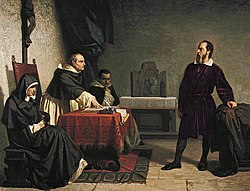Galileo - Church Controversy - Wikipedia
http://en.wikipedia.org/wiki/Galileo#Church_controversy
- Main article: Galileo affair
Psalms 93:1 and Psalm 104:5, and Ecclesiastes 1:5 speak of the (in some sense) "firm" and "established" position of the earth. Galileo defended heliocentrism, and claimed it was not contrary to those Scripture passages. He took Augustine's position on Scripture: not to take every passage too literally, particularly when the scripture in question is a book of poetry and songs, not a book of instructions or history. The writers of the Scripture wrote from the perspective of the terrestrial world, and from that vantage point the sun does rise and set. In fact, it is the earth's rotation which gives the impression of the sun in motion across the sky.
By 1616 the attacks on Galileo had reached a head, and he went to Rome to try to persuade the Church authorities not to ban his ideas. In the end, Cardinal Bellarmine, acting on directives from the Inquisition [1], delivered him an order not to "hold or defend" the idea that the Earth moves and the Sun stands still at the center. The decree did not prevent Galileo from hypothesizing heliocentrism. For the next several years Galileo stayed well away from the controversy.
He revived his project of writing a book on the subject, encouraged by the election of Cardinal Barberini as Pope Urban VIII in 1623. Barberini was a friend and admirer of Galileo, and had opposed the condemnation of Galileo in 1616. The book, Dialogue Concerning the Two Chief World Systems, was published in 1632, with formal authorization from the Inquisition and papal permission.
Pope Urban VIII personally asked Galileo to give arguments for and against heliocentrism in the book, and to be careful not to advocate heliocentrism. He made another request, that his own views on the matter be included in Galileo's book. Only the latter of those requests was fulfilled by Galileo. Whether unknowingly or deliberate, Simplicius, the defender of the Aristotelian Geocentric view in Dialogue Concerning the Two Chief World Systems, was often caught in his own errors and sometimes came across as a fool. This fact made Dialogue Concerning the Two Chief World Systems appear as an advocacy book; an attack on Aristotelian geocentrism and defense of the Copernican theory. To add insult to injury, Galileo put the words of Pope Urban VIII into the mouth of Simplicius. Most historians agree Galileo did not act out of malice and felt blindsided by the reaction to his book. However, the Pope did not take the public ridicule lightly, nor the blatant bias. Galileo had alienated one of his biggest and most powerful supporters, the Pope, and was called to Rome to explain himself.
With the loss of many of his defenders in Rome because of Dialogue Concerning the Two Chief World Systems, Galileo was ordered to stand trial on suspicion of heresy in 1633. The sentence of the Inquisition was in three essential parts:
- Galileo was required to recant his heliocentric ideas; the idea that the Sun is stationary was condemned as "formally heretical".
- He was ordered imprisoned; the sentence was later commuted to house arrest.
- His offending Dialogue was banned; and in an action not announced at the trial and not enforced, publication of any of his works was forbidden, including any he might write in the future.
After a period with the friendly Ascanio Piccolomini (the Archbishop of Siena), Galileo was allowed to return to his villa at Arcetri near Florence, where he spent the remainder of his life under house arrest. It was while Galileo was under house arrest when he dedicated his time to one of his finest works, Two New Sciences. This book has received high praise from both Sir Isaac Newton and Albert Einstein. As a result of this work, Galileo is often called, the "father of modern physics."
Galileo was reburied on sacred ground at Santa Croce in 1737. He was formally rehabilitated in 1741, when Pope Benedict XIV authorized the publication of Galileo's complete scientific works (a censored edition had been published in 1718), and in 1758 the general prohibition against heliocentrism was removed from the Index Librorum Prohibitorum. On 31 October 1992, Pope John Paul II expressed regret for how the Galileo affair was handled, as the result of a study conducted by the Pontifical Council for Culture.
In modern scientific terms, we consider Galileo's views on heliocentricity to be no fundamental advance. The heliocenticity model that Galileo presented was no more accurate than the Tychonic system model, the main competing theory at the time. Stellar parallax, the first evidence from outside the solar system that the Earth does indeed move, would be not observed until the 1838 (Consolmagno 150-152). Today, we know the Sun is no more the center of the universe than the Earth is, as it has its own orbit in the Milky Way Galaxy, just like the galilean moons of Jupiter have orbits around Jupiter while Jupiter orbits the Sun. The Catholic Church held to the prevailing theological opinion of the day, which was that the Earth was the center of the universe. For some, the key issue of this controversy was not the objective correctness of the theories being debated, but rather the morality of institutions (or persons) to shape the acceptance of scientific knowledge[citation needed]. For others, it reflects a time where science had not fully separated from its theological and philosophical roots.


1 Comments:
Take a look at my blog. I have a lot of material on geocenrtism including a 4-part series showing geocentrism has not been discredited, and a book review for the recent book Galileo Was Wrong by Robert Sungenis Ph.D., and Robert Bennett, Ph.D.
Mark Wyatt
veritas-catholic.blogspot.com
Post a Comment
<< Home